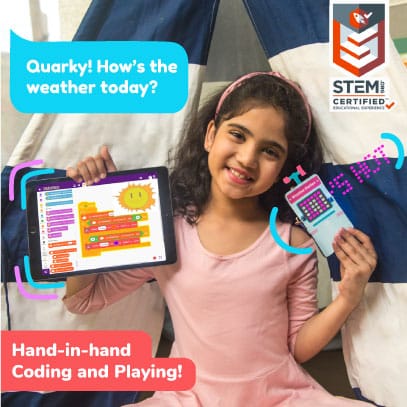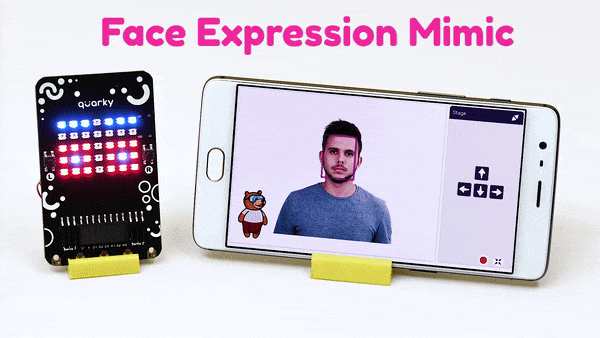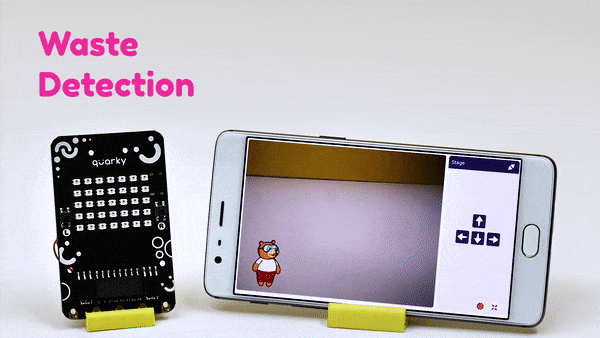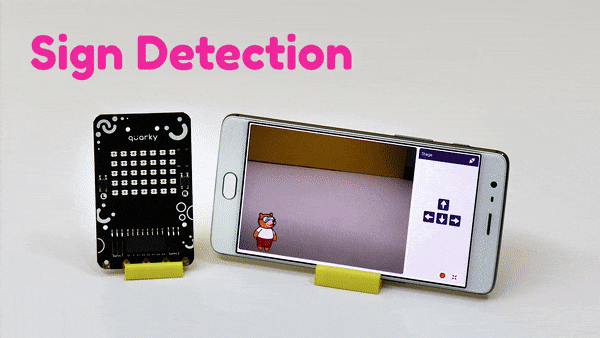- Curriculum
- >
- Skill Development Courses
- >
- Learn AI with Quarky – Curriculum
Learn AI with Quarky – Curriculum

Introduction
Learn AI with Quarky is an AI curriculum for activity centers, schools, and self-learners for teaching the concepts of Physical Computing, Artificial intelligence, and coding to kids in an interactive and playful manner through engaging real-life projects.
- Prerequisites: None
- Kits Required: Quarky Explorer Kit or Quarky Innovation Kit or Quakry Ultimate Kit or Classroom Bundles
- Programming Software: PictoBlox (Block Coding)
Learning Outcomes
After completing this curriculum, students will have a basic understanding of artificial intelligence techniques with the help of a wide variety of AI projects.
Apart from the aforementioned learning outcomes, this curriculum will also help them develop important skills such as problem-solving and debugging techniques, critical thinking, logical reasoning, and creativity.
12
Lessons
15+
Activities
20+
Learning Hours
5+
Grades
Curriculum Lesson Plan

Lesson 1: Say Hello to Quarky
- Objective: Getting familiar with Quarky and PictoBlox - the tools used in this curriculum.
- Activity 1: Understanding the various parts of Quarky (LED Matrix, Switches, & Touch sensors etc.)
- Activity 2: Programming Quarky to display various predefined expressions on the LED Display.
- Learning Outcome: Describe Quarky features | Program Quarky with PictoBlox and create various emojis
- Mode: Practical (Physcial Computing)

Lesson 2: Light. Display. Fun!
- Objective: Learn the various programming blocks to control the RGB LEDs of the Quarky.
- Activity 1: Create a name badge which displays the text contraining student name and hobby.
- Activity 2: Making a custom animation of beating heart on Quarky.
- Learning Outcome: Describe the various options to program the RGB LEDS | Demonstrate animation creating on Hardware.
- Mode: Practical (Physcial Computing)

Lesson 3: Fun with Music
- Objective: Learn to use Quarky touch sensor to create interactive projects.
- Activity 1: Touch-based piano - Use Quarky’s touch pins to play different notes.
- Activity 2: Dance Party - Use Quarky’s touch pins to host an entire dance party - controlling different aspects of our party – music, lights, and also our sprite’s moves!
- Learning Outcome: Demonstrate the use of Quarky's touch pin to make actions on the stage.
- Mode: Practical (Physcial Computing)

Lesson 4: Play Time!
- Objective: Learn how to make game in PictoBlox using Quarky switches.
- Activity 1: Making a sprite move with Quarky's switches.
- Activity 2: Create the game Catch the Fruit - The aim is of the game is to make the Monkey catch as many fruits as possible by controlling it using Quarky’s switches.
- Learning Outcome: Describe game development process | Describe use of condition and loops in games | Demonstrate use of Quaky's switches.
- Mode: Practical (Physcial Computing)

Lesson 5: Face Mimic with Quarky
- Objective: Learn about artificial intelligence, face detection and create a interative projects woking with Quarky.
- Activity 1: Face Expression Detector - Create a code to detect the expression of the face detected.
- Activity 2: Create code to make Quarky mimic the expression detected by PictoBlox.
- Learning Outcome: Understand what is artificial intelligence | Appreciate the advantages of using AI | Correlate with the real-world applications of AI to generate an AI mindset.
- Mode: Practical (Physcial Computing)

Lesson 6: Weather Monitoring System
- Objective: Learn all about weather and weather monitoring systems – what they are, why they’re important, and what are their advantages.
- Activity 1: Make your own weather monitoring system using Quarky and PictoBlox.
- Learning Outcome: Understand what weather and weather monitoring are | Appreciate the advantages of weather monitoring | Make weather monitoring system
- Mode: Practical (Physcial Computing)

Lesson 7: Waste Management System
- Objective: Learn all about waste management system. Learn object detection to identify waste. Learn how to use text to speech in PictoBlox.
- Activity 1: Waste Classifier - If it detects biodegradable waste, the LEDs Quarky’s matrix will turn green. If it’s non-biodegradable waste, the LEDs will turn blue.
- Learning Outcome: Understand what waste is and its type | Understand the importance of waste management | Appreciate the advantages of waste management.
- Mode: Practical (Physcial Computing)

Lesson 8: Road Safety with Quarky
- Objective: Learn about roads and road safety – its importance and advantages. Learn how to use AI to detect various road signs.
- Activity 1: Road Safety System - Detect the sign using a camera and display it on Quarky’s LED matrix. It will also make Quarky speak out the name of the sign on its speaker.
- Learning Outcome: Understand what road safety and the role of road signs | Appreciate the advantages of road safety | Make your AI-based road safety system using Quarky and PictoBlox.
- Mode: Practical (Physcial Computing)

Lesson 9: Face Recognition with Quarky
- Objective: Learn about face recognition, a pretty useful application of artificial intelligence.
- Activity 1: Security System - PictoBlox will first detect our face. Then, it will match with the face(s) already saved. If the detected face and the saved face match, Quarky will display a green color. Otherwise, it will continue displaying the red color.
- Learning Outcome: Understand the importance of having a security system | Understand what face recognition is and how face recognition-based systems work | Make your own face recognition-based security system using Quarky and PictoBlox.
- Mode: Practical (Physcial Computing)

Lesson 10: Home Automation System – NLP
- Objective: Learn about home automation – a smart way to easily control the different household features such as lighting, security, and other appliances.
- Activity 1: Text Classifier with NLP - Train PictoBlox to classify a message as turning ON lights or turning OFF lights.
- Learning Outcome: Understand what home automation is | Appreciate the advantages and applications of home automation | Understand about Natural Language Processing to create text classifiers in PictoBlox.
- Mode: Practical (Physcial Computing)
Lesson 11: Home Automation System – Part 2
- Objective: Learn about speech recognition to make your own alexa.
- Activity 1: Voice Recognition - Make the script to enable the system to detect voice.
- Activity 2: Home Automation System - The system will use voice commands to control the lights of the room. Record and understand the command and perform the corresponding action – either to turn ON or turn OFF the light.
- Learning Outcome: Understand speech recognition and create home automation system.
- Mode: Practical (Physcial Computing)
Lesson 12: Capstone Project
- The final lesson of the Learn AI with Quarky curriculum for schools is where students get to apply all the concepts they have learned in the previous sections to make a project to solve a real-world problem of their choice.




